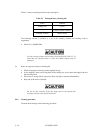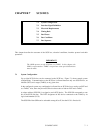6 - 2 C156-E097-01EN
6.1.1 Initial self-diagnosis
When the power is turned on, the optical disk drive starts initial self-diagnosis. Basic hardware
functions are tested during initial self-diagnosis.
The hardware function test checks the normality of the basic controller operation. This test
includes the normality check of the ROM in which microcodes are stored, microprocessor
(MPU) peripheral circuit test, memory (RAM) test, and data buffer test.
If an error is detected during initial self-diagnosis, the LED on the drive front panel blinks. The
drive posts the CHECK CONDITION status to all input/output operation requests other than the
REQUEST SENSE and INQUIRY commands. It also returns the MESSAGE REJECT message
in response to messages except the IDENTIFY message. The initiator should issue the
REQUEST SENSE command if the CHECK CONDITION status is posted. Sense data obtained
by the REQEST SENSE command explains in detail the error detected during initial self-
diagnosis. This status is held and the LED on the front panel blinks continuously even if the
CHECK CONDITION status or sense data is posted. This status can be cleared only when
RESET is executed for the SCSI bus or the power is turned off or on. The drive reexecutes initial
self-diagnosis when this status is cleared.
6.1.2 Diagnostic command
The host system can make the ODD execute the self diagnosis by issuing The SEND
DIAGNOSTIC command with specifying the Self Test operation. When the self diagnosis
terminates successfully, a GOOD status is reported. When the self diagnosis terminates
abnormally, a CHECK CONDITION status is reported. In this case, HARDWARE ERROR
[=4] is set in the sense key and the detail error code is set in the additional sense key.
6.1.3 Test program
A test program running in the host system is required to check general operations such as
operations of the interface with the host system and simulated operations.
The configuration and function of the test program depend on the user system requirements.
Prepare a general input-output test program which applies to all SCSI devices connected to the
SCSI bus and input-output equipment at other input-output ports.
The test program should include the following tests:
(1) Interface (SCSI bus) test
Use the WRITE BUFFER and READ BUFFER commands to check SCSI bus operations and
whether the data buffer in the drive is normal.
(2) Random/sequential read test
Use the READ or VERIFY command to test positioning (seek) operation and read operation in
random access mode and sequential access mode.


















